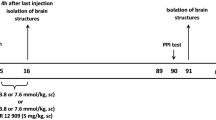Abstract
The present study examined the effects of early postnatal treatment with a beta-adrenoceptor antagonist propranolol (5 mg/kg IP daily) on concomitant and subsequent behavior and central aminergic transmission in rats. During propranolol exposure from the 7th to the 20th postnatal days sleep-wake recordings, carried out with the static charge sensitive bed (SCSB) method, showed a decrease in the percentage of active sleep and an increase in waking. When the animals were 1–3 months of age, the open field behavior was changed, immobility time in the Porsolt's swim test was lengthened, and voluntary alcohol consumption was increased in the propranolol-treated rats. Neither motor reactivity to auditory stimuli nor spontaneous alternation behavior was affected. At the age of 4 months concentrations of brain amines and their metabolites were measured from several brain regions. In the propranolol-treated rats the noradrenaline levels were increased in the limbic forebrain and cerebellum. The results suggest that in rats the exposure to propranolol during the rapid growth period of cerebral catecholamine systems, and the concomitant alterations in sleep are related to later changes in behavior and to increased noradrenaline content in the limbic forebrain and cerebellum.
Similar content being viewed by others
References
Alihanka J, Vaahtoranta K, Saarikivi J (1981) A new method of long-term monitoring of the ballistocardiogram, heart rate and respiration. Am J Physiol 240:384–392
Bruinink A, Lichtensteiger W (1984) β-Adrenergic binding sites in fetal rat brain. J Neurochem 43:578–581
Caciagli F, Giacobini E, Paoletti R (1984) Developmental neurosciences: physiological, pharmacological and clinical aspects. Elsevier, Amsterdam
Cuomo V (1987) Perinatal neurotoxicology of psychotropic drugs. TIPS 8:346–350
Donoso AO, Barontini M (1986) Increase in plasma catecholamines by intraventricular injection of histamine in conscious rats. Naunyn-Schmiedeberg's Arch Pharmacol 334:188–192
Habib A, McCarthy JS (1977) Effects on the neonate of propranolol administered during pregnancy. J Pediatr 9:808–811
Hilakivi I (1983) The role of β- and α-adrenoceptors in the regulation of the sleep-waking cycle in the cat. Brain Res 227:109–118
Hilakivi LA, Hilakivi I (1986) Sleep-wake recordings in newborn rats by using a movement sensitive method. Behav Brain Res 19:241–248
Hilakivi LA, Hilakivi I (1987) Increased adult behavioral “despair” in rats neonatally exposed to desipramine or zimeldine: an animal model of depression? Pharmacol Biochem Behav 28:367–369
Hilakivi I, Makela J, Leppavuori A, Putkonen PTS (1978) Effects of two adrenergic β-receptor blockers on the sleep cycle of the cat. Med Biol 556:138–143
Hilakivi LA, Hilakivi I, Ahtee L, Haikala H, Attila M (1987a) Effect of neonatal nomifensine exposure on adult behavior and brain monoamines in rats. J Neural Transm 70:99–116
Hilakivi LA, Stenberg D, Sinclair JD, Kiianmaa K (1987b) Neonatal desipramine or zimeldine treatment causes long-lasting changes in brain monoaminergic systems and alcohol related behaviors in rats. Psychopharmacology 91:403–409
Hilakivi LA, Taira T, Hilakivi I (1988) Early postnatal deprivation of active sleep with desipramine or zimeldine impairs later behavioral reactivity to auditory stimuli in rats. Acta Physiol Scand 132:191–198
Lanfumey L, Adrien J (1982) Regulation of sleep after neonatal locus coeruleus lesion: functional evidence of beta-adrenergic supersensitivity. Eur J Pharmacol 79:257–264
Lanfumey L, Dugovic C, Adrien J (1985) β1- and β2-adrenergic receptors: their role in the regulation of paradoxical sleep in the rat. Electroencephalogr Clin Neurophysiol 60:558–567
Maj J, Przegalinski E, Mogilnicka E (1984) Hypothesis concerning the mechanism of action of antidepressant drugs. Rev Physiol Biochem Pharmacol 100:1–74
Mefford IN (1981) Application of high performance liquid chromatography with electrochemical detection to neurochemical analyses: measurement of catecholamines, serotonin and metabolites in rat brain. J Neurosci Methods 3:207–224
Middlemiss DN, Blakeborough L, Leather SR (1977) Direct evidence for an interaction of beta-adrenergic blockers with the 5-HT receptor. Nature 267:289–290
Pittman RN, Minneman KP, Molinoff PB (1980) Ontogeny of β1- and β2-adrenergic receptors in rat cerebellum and cerebral cortex. Brain Res 188:357–368
Porsolt RD, Le Pichon M, Jalfre M (1977) Depression: a new animal model sensitive to antidepressant treatments. Nature 266:730–732
Pruyn SC, Phelan JP, Buchanan GC (1979) Long-term propranolol therapy in pregnancy: maternal and fetal outcome. Am J Obstet Gynecol 135:485–489
Riley EP, Lochry EA, Shapiro NR (1979) Lack of response inhibition in rat prenatally exposed to alcohol. Psychopharmacology 62:47–62
Swaab DF, Mirmiran M (1984) Possible mechanisms underlying the teratogenic effects of medicines on the developing brain. In: Yanai Y (ed) Neurobehavioral teratology. Elsevier, Amsterdam, pp 55–71
Weinstock M, Weiss C, Gitter S (1977) Blockade of 5-hydroxytryptamine receptors in the central nervous system by β-adrenoceptor antagonists. Neuropharmacology 16:273–276
Yamatodani A, Fukuda H, Wada H, Iwaeda T, Watanabe T (1985) High performance liquid chromatographic determination of plasma and brain histamine without previous purification of biological samples: cation-exchange chromatography coupled with post-column derivatization fluorometry. J Chromatogr 344:115–123
Author information
Authors and Affiliations
Rights and permissions
About this article
Cite this article
Hilakivi, L.A., Taira, T., Hilakivi, I. et al. Early postnatal treatment with propranolol affects development of brain amines and behavior. Psychopharmacology 96, 353–359 (1988). https://doi.org/10.1007/BF00216061
Received:
Revised:
Issue Date:
DOI: https://doi.org/10.1007/BF00216061




